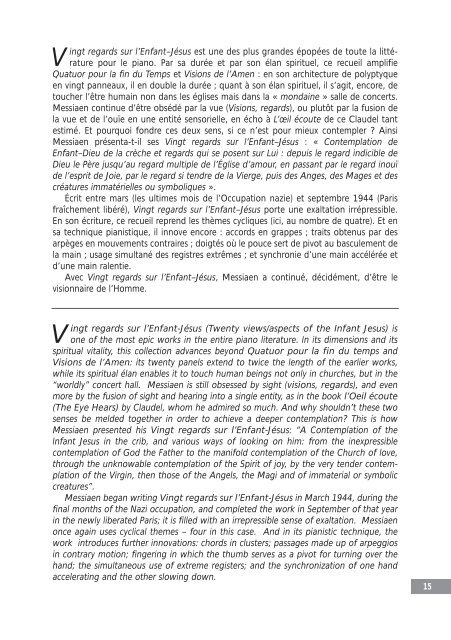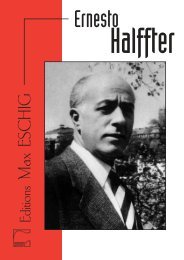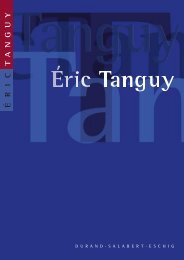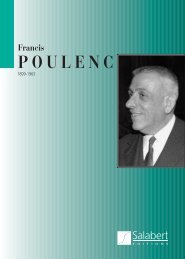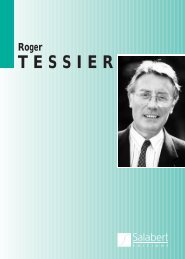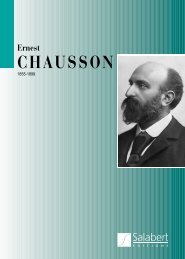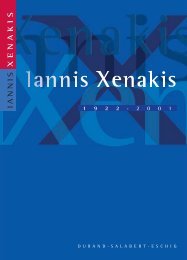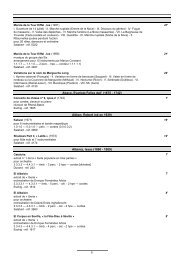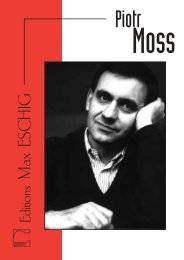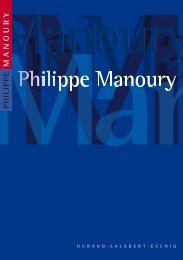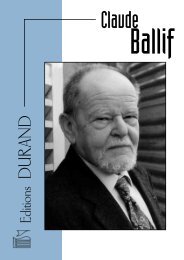messiaen olivier 1 9 0 8 - Durand Salabert Eschig
messiaen olivier 1 9 0 8 - Durand Salabert Eschig
messiaen olivier 1 9 0 8 - Durand Salabert Eschig
Create successful ePaper yourself
Turn your PDF publications into a flip-book with our unique Google optimized e-Paper software.
Vingt regards sur l’Enfant–Jésus est une des plus grandes épopées de toute la littérature<br />
pour le piano. Par sa durée et par son élan spirituel, ce recueil amplifie<br />
Quatuor pour la fin du Temps et Visions de l’Amen : en son architecture de polyptyque<br />
en vingt panneaux, il en double la durée ; quant à son élan spirituel, il s’agit, encore, de<br />
toucher l’être humain non dans les églises mais dans la « mondaine » salle de concerts.<br />
Messiaen continue d’être obsédé par la vue (Visions, regards), ou plutôt par la fusion de<br />
la vue et de l’ouïe en une entité sensorielle, en écho à L’œil écoute de ce Claudel tant<br />
estimé. Et pourquoi fondre ces deux sens, si ce n’est pour mieux contempler ? Ainsi<br />
Messiaen présenta-t-il ses Vingt regards sur l’Enfant–Jésus : « Contemplation de<br />
Enfant–Dieu de la crèche et regards qui se posent sur Lui : depuis le regard indicible de<br />
Dieu le Père jusqu’au regard multiple de l’Église d’amour, en passant par le regard inouï<br />
de l’esprit de Joie, par le regard si tendre de la Vierge, puis des Anges, des Mages et des<br />
créatures immatérielles ou symboliques ».<br />
Écrit entre mars (les ultimes mois de l’Occupation nazie) et septembre 1944 (Paris<br />
fraîchement libéré), Vingt regards sur l’Enfant–Jésus porte une exaltation irrépressible.<br />
En son écriture, ce recueil reprend les thèmes cycliques (ici, au nombre de quatre). Et en<br />
sa technique pianistique, il innove encore : accords en grappes ; traits obtenus par des<br />
arpèges en mouvements contraires ; doigtés où le pouce sert de pivot au basculement de<br />
la main ; usage simultané des registres extrêmes ; et synchronie d’une main accélérée et<br />
d’une main ralentie.<br />
Avec Vingt regards sur l’Enfant–Jésus, Messiaen a continué, décidément, d’être le<br />
visionnaire de l’Homme.<br />
Vingt regards sur l’Enfant-Jésus (Twenty views/aspects of the Infant Jesus) is<br />
one of the most epic works in the entire piano literature. In its dimensions and its<br />
spiritual vitality, this collection advances beyond Quatuor pour la fin du temps and<br />
Visions de l’Amen: its twenty panels extend to twice the length of the earlier works,<br />
while its spiritual élan enables it to touch human beings not only in churches, but in the<br />
“worldly” concert hall. Messiaen is still obsessed by sight (visions, regards), and even<br />
more by the fusion of sight and hearing into a single entity, as in the book l’Oeil écoute<br />
(The Eye Hears) by Claudel, whom he admired so much. And why shouldn’t these two<br />
senses be melded together in order to achieve a deeper contemplation? This is how<br />
Messiaen presented his Vingt regards sur l’Enfant-Jésus: “A Contemplation of the<br />
Infant Jesus in the crib, and various ways of looking on him: from the inexpressible<br />
contemplation of God the Father to the manifold contemplation of the Church of love,<br />
through the unknowable contemplation of the Spirit of joy, by the very tender contemplation<br />
of the Virgin, then those of the Angels, the Magi and of immaterial or symbolic<br />
creatures”.<br />
Messiaen began writing Vingt regards sur l’Enfant-Jésus in March 1944, during the<br />
final months of the Nazi occupation, and completed the work in September of that year<br />
in the newly liberated Paris; it is filled with an irrepressible sense of exaltation. Messiaen<br />
once again uses cyclical themes – four in this case. And in its pianistic technique, the<br />
work introduces further innovations: chords in clusters; passages made up of arpeggios<br />
in contrary motion; fingering in which the thumb serves as a pivot for turning over the<br />
hand; the simultaneous use of extreme registers; and the synchronization of one hand<br />
accelerating and the other slowing down.<br />
15


